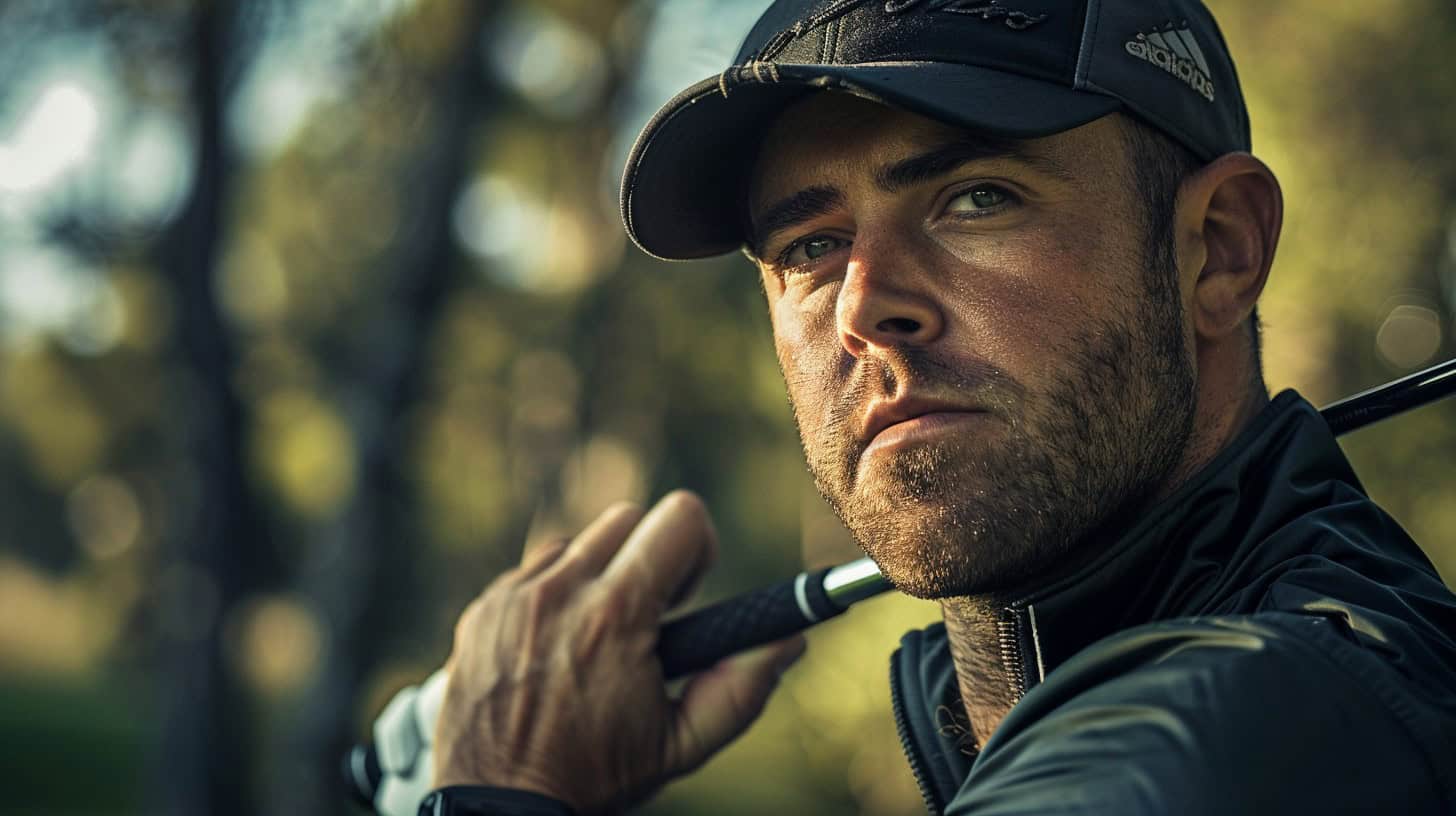Golfing is one of those engaging hobbies that not only gets you moving around but also significantly boosts mental health. However, many golfers struggle with their golf swing due to improper grip techniques.
Ensuring a correct grip can drastically improve your performance on the golf course, making your swings more accurate and powerful. One effective way to practice this is to buy a golf simulator. This allows you to train and refine your technique in the comfort of your own home, regardless of weather conditions.
As someone who has spent years refining my own technique, I know firsthand how crucial a proper grip is. It’s all about the details—like hand positioning and adjusting your grip strength—these small tweaks make all the difference. 1 Master this fundamental skill… and watch your game transform!
Key Takeaways
A proper golf grip involves balanced pressure and correct hand positioning; two knuckles on the left hand should be visible, and a V-shape formed by thumbs should aim towards the right shoulder.
The 10-finger grip is ideal for beginners and seniors, while the overlapping (Vardon) grip offers better control. The interlocking grip provides comfort for those with smaller hands.
For drivers, maintain a light, but firm hold to optimize power; use marked gloves for practice. For putters, apply consistent light pressure with thumbs aligned down the middle of the putter’s grip for stability.
Common errors include holding the club too tightly or in the palm instead of fingers. Solutions involve relaxing your hands and ensuring equal pressure between both hands.
Practicing different grips with various clubs can enhance swings’ accuracy and power, leading to improved golfing performance overall.
Table of Contents
Key Components of a Proper Golf Grip
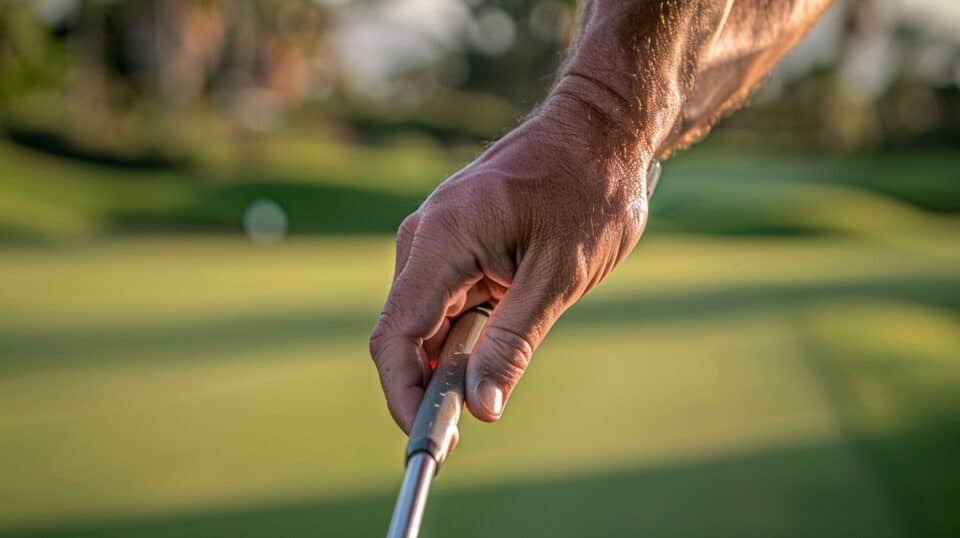
Grip the golf club with balanced pressure to control the club face. Place your left hand correctly so that two knuckles are visible when looking down.
Adjusting Grip Pressure
Hold the golf club with a pressure of about four or five on a scale from one to ten. 1 Your hands should be firm yet relaxed, allowing for some movement. This balance helps avoid strangling the golf club and gives you better control of the swing.
Soft grip pressure keeps your wrists flexible, making it easier to execute smooth swings. 2
Tighten your grip slightly when hitting tough shots, but never squeeze too hard as it can restrict motion.
Keep practicing until this grip feels natural and becomes muscle memory.
Correct Hand Positioning
Place the golf club handle in your left palm so it lies diagonally across your fingers. 3 Keep two knuckles visible on this hand. The crease between the thumb and index finger should aim toward the right shoulder.
For a neutral grip, ensure your right hand’s thumb falls naturally beside your left. 4 Crease between thumb and index finger of the right hand forms a “V” shape pointing to mid-sternum.
Exploring Different Golf Grips
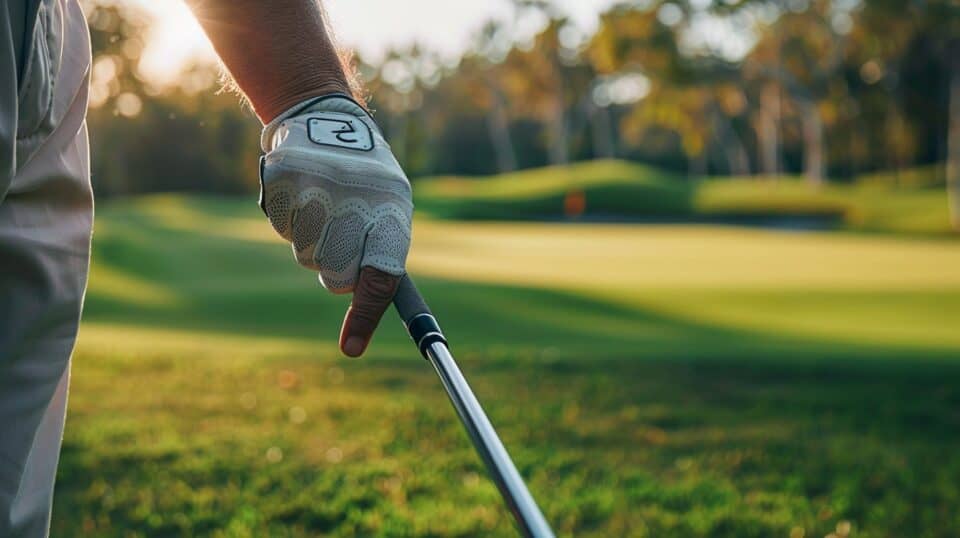
Each golf grip offers a unique feel and control. Try them to see which works best for you….
The 10-Finger Grip
The 10-finger grip, or “baseball grip,” is ideal for beginners. Place the non-dominant hand on the club’s handle underneath and wrap your fingers around it. Next, position the dominant hand above the non-dominant one.
This method helps generate maximum power to strike the golf ball with force. 5
Many seniors and those with weaker joints prefer this grip. It promises increased backspin and better shot distance. However, it might be challenging to balance both hands correctly…
Some golfers also experience excessive spin using this technique. 6
The Overlapping Grip
Slide your little finger off the grip and place it between the left index and middle fingers. This grip helps both hands work as one during your swing. Known as the Vardon grip, it’s a popular choice among many golfers. 4
The overlapping grip is also called the overlap grip. It ensures better control of the golf club by uniting both hands. Harry Vardon, a famous golfer, made this method well-known. Using this technique can improve your swing accuracy significantly. 7
The Interlocking Grip
The interlocking grip joins the pinky finger of your bottom hand with the index finger of your top hand. It offers more control over golf clubs during swings. Many players find this comfortable, especially those with smaller hands or lefties adapting to typical grips. 4
Two knuckles should be visible on the top hand for proper positioning. This ensures a firm hold without too much pressure. Practicing different thicknesses of grips can help achieve a snug fit based on hand size. 7
Grip it and rip it! – Common golfer’s saying
Grip Techniques for Various Golf Clubs
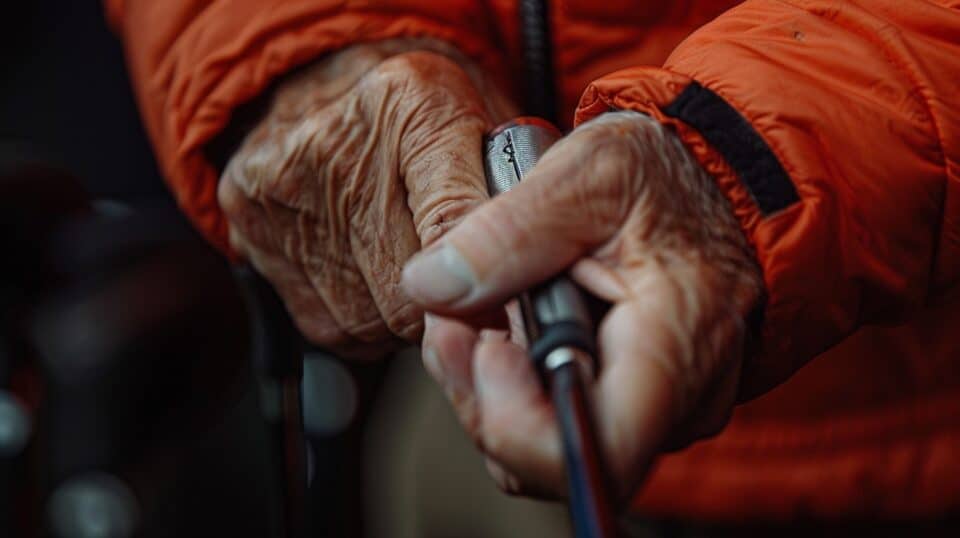
Different clubs need different grips. For drivers, hold the club lightly but firm for power… With putters, you want a soft grip to control your short shots.
Gripping a Driver
Hold a driver correctly to hit long, straight drives. Pay attention to your grip for the best performance. 7
- Grip Pressure
- Hold the club like you are holding a small bird.
- Aim for a pressure of 4 or 5 on a scale from 1 to 10. 1
- Lead Hand Positioning
- Place the club partly in your fingers and partly in your palm.
- Form a V-shape with your thumb and forefinger pointing toward your trail shoulder.
- Let one, two, or three knuckles show on this hand. 1
- Trail Hand Placement
- Place this hand under the club.
- Ensure the lifeline sits atop your lead thumb.
- Practice with Marked Gloves
- Use marked gloves to help you place your hands correctly.
These steps ensure a strong grip on your driver, leading to more powerful and accurate shots.
Gripping a Putter
Gripping a putter may seem simple, but doing it right makes a huge difference. Follow these steps to master your putter grip:
- Reverse Overlap Grip:
- Place the lead hand above the right hand.
- Lay both thumbs down at the center of the grip.
- Correct Pressure:
- Apply consistent and light pressure on a scale of 1 to 10, aiming for around 4 or 5. 1
- Knuckles Visibility:
- Ensure the knuckles of your lead hand are visible. This helps maintain control.
- Club Face Alignment:
- Position hands so that the club face stays square to your swing path. 7
- Thumbs Placement:
- Keep both thumbs running down the middle of the putter’s grip for stability.
- Avoid Tightening Grip:
- Do not squeeze too hard, as this can affect the smoothness of the swing.
- Practice Adjusting Hand Positioning:
- Try small adjustments in practice to find what feels best for you.
Common Golf Grip Errors and Solutions
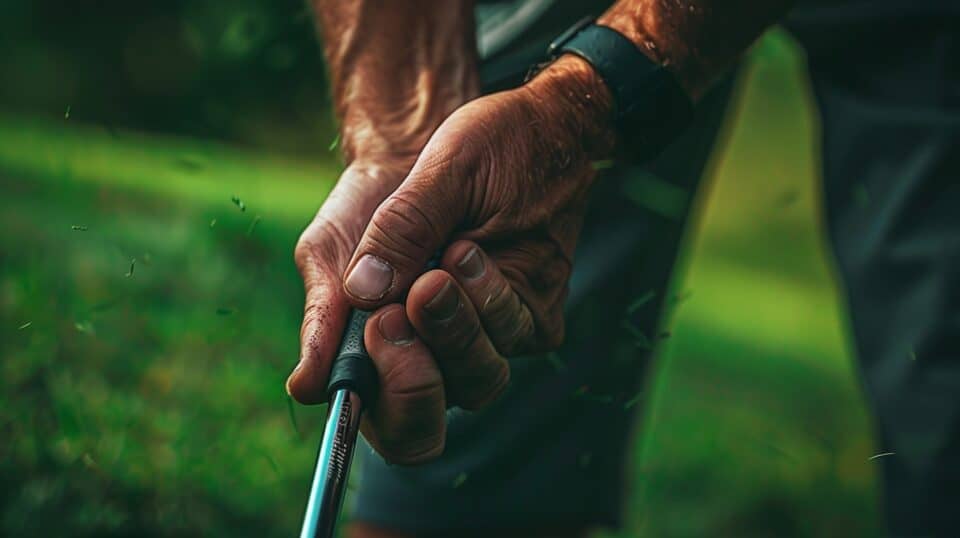
A good golf grip is key in improving your game. Many common errors can affect your swing.
- Holding the Club Too Tightly: A tight grip can restrict wrist movement and reduce swing speed. 8 Solution: Relax your hands and adjust grip pressure. Your grip should be firm but not tense.
- Gripping in the Palm Instead of Fingers: This error reduces control. Solution: Position the lead hand so that it holds the club more in the fingers than the palm.
- Incorrect V Formed by Thumb and Forefinger: The V should point towards the trail shoulder. Solution: Place your thumb correctly to form a V with the forefinger pointing to the right direction. 1
- Uneven Grip Pressure Between Hands: Uneven pressure creates an unbalanced swing. Solution: Ensure equal pressure from both hands for consistency.
- Wrong Hand Placement: Poor hand positioning impacts accuracy and power. Solution: Check that both hands are properly aligned on the grip, ensuring correct hand placement every time you aim for a perfect chip shot or use different clubs like a driver or putter.
Fix these errors to hit straighter shots and improve your overall golfing performance!
People Also Ask
What is the proper way to hold a golf club?
The proper way involves placing your left hand on the grip first, then your right hand below it, ensuring both thumbs point down.
Why does my grip affect my swing?
Your grip affects control and power. A correct grip helps you move around smoothly during swings.
How can I fix common golf grip errors?
To fix common errors like gripping too tight or loose, practice holding the club with consistent pressure using both hands equally.
Can changing my grip improve my game?
Yes! Adjusting your grip can lead to better accuracy and more powerful shots by allowing smoother movements.
References
- ^ https://www.youtube.com/watch?v=EbVqyN_VBF4
- ^ https://milolinesgolf.com/grip-pressure-and-its-effect-in-the-golf-swing-hold-the-golf-club-the-right-way/
- ^ https://golf.com/instruction/how-to-hold-a-golf-club-the-proper-golf-grip/ (2019-04-25)
- ^ https://propergolfing.com/proper-golf-grip-a-step-by-step-guide-to-a-perfect-swing/
- ^ https://www.gearssports.com/articles/ten-finger-golf-grip/
- ^ https://www.performforgolf.com/blog/golf-grips-how-to-hold-a-golf-club
- ^ https://www.curated.com/journal/45000/how-to-grip-a-golf-club (2023-03-13)
- ^ https://v1sports.com/the-grip-golfs-club-body-connection-is-critical-to-success/ (2024-03-28)
